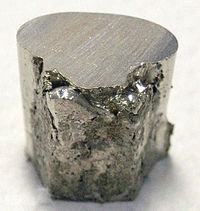
Photo from wikipedia
Salicylhydroxamic acid is an excellent collector of oxidizing ore, and it has an efficient collection performance for tungsten molybdenum ore. However, the utilization ratio of salicylhydroxamic acid is relatively low… Click to show full abstract
Salicylhydroxamic acid is an excellent collector of oxidizing ore, and it has an efficient collection performance for tungsten molybdenum ore. However, the utilization ratio of salicylhydroxamic acid is relatively low in the flotation process, and a large amount of flotation wastewater discharged might cause damage to the water environment. This study mainly compared the effects of natural sunlight degradation, ozonation, and Fenton oxidation processes on the treatment of salicylchydroxamic acid wastewater from W–Mo mineral processing. The results showed after 30 hours degradation by natural sunlight, the CODcr removal rate of wastewater was only 25.99%. When the initial pH was 8, the dosage of O3 was 1.3 mg/L and the reaction time was 60 minutes; O3 oxidation could remove 40.37% CODcr from wastewater, and the BOD5/CODcr value increased to higher than 0.3 after 15 min reaction. Under the Fenton oxidation conditions such as initial pH 3, H2O2 dosage 0.96 g/L, and the molar ratio of H2O2 to Fe2+ 2 : 1, 90.43% CODcr could be removed from flotation wastewater after 90 min reaction, and the BOD5/CODcr value was obviously improved. Fenton oxidation was a high efficient processing technology for salicylhydroxamic acid wastewater, and the effluent could meet the discharge and reuse emission standard requirements in China.
Journal Title: Journal of Chemistry
Year Published: 2020
Link to full text (if available)
Share on Social Media: Sign Up to like & get
recommendations!